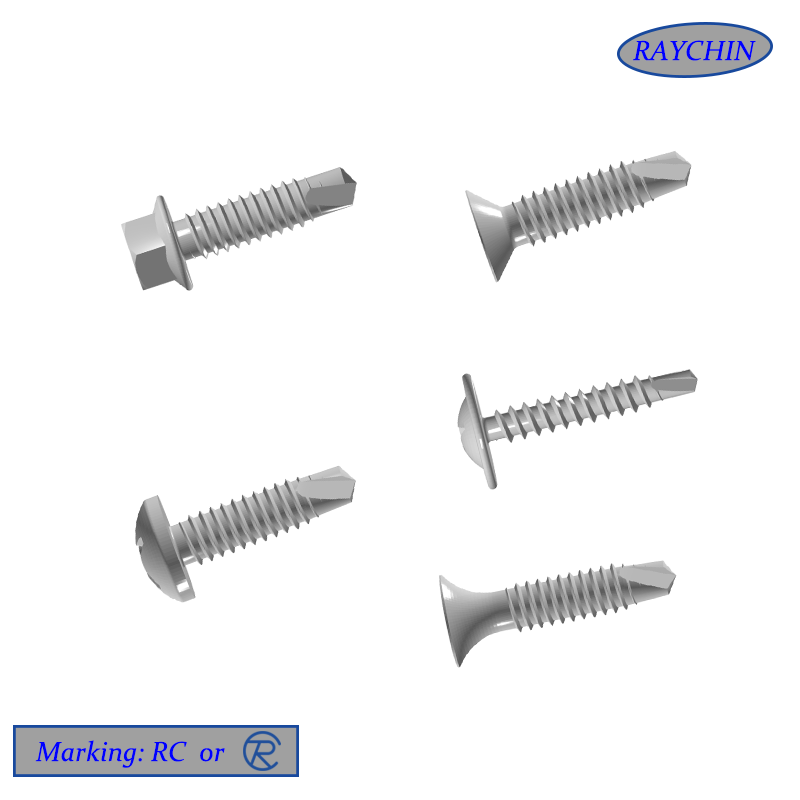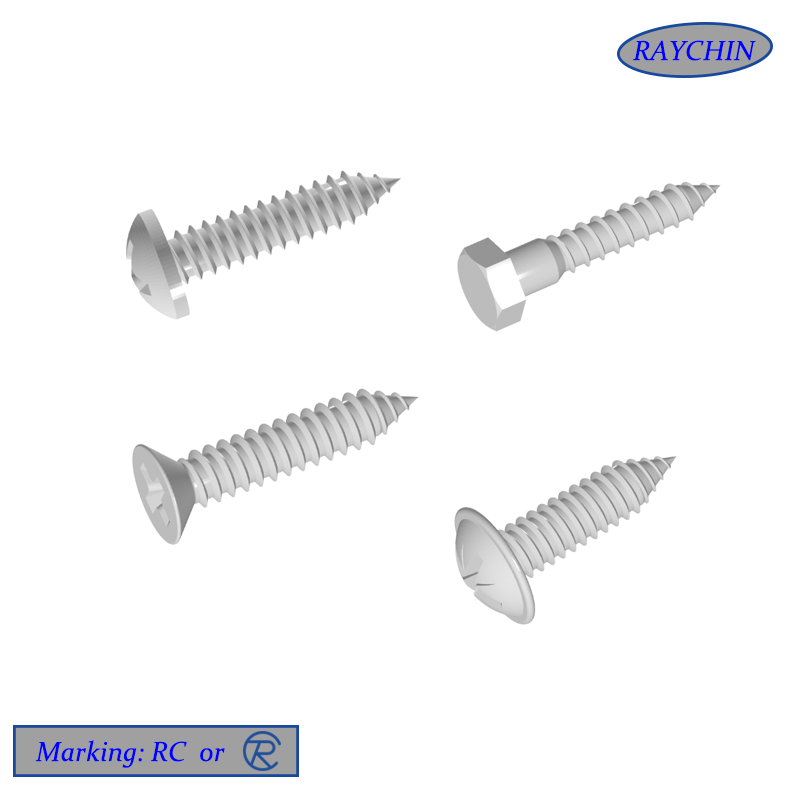
DRILL POINT | Self-drilling screws are screws with a drill-shaped tip that can drill into materials without the need for a pilot hole. The tip of the screw is designed to drill a pilot hole that's the right size for the screw's threads to cut. Self-drilling screws don't require a pre-drilled pilot hole, which can save time and money. The screw's point has flutes or cutting edges that remove material as the screw is driven in. The screw's tip has a notched area that collects wood chips or metal filings, allowing the drill to move through the material without being blocked. Self-drilling screws come with different drill points for different material thicknesses. The larger the number on the drill point, the thicker the metal the screw can go through without a pilot hole. Self-drilling screws shouldn't be used in blind holes.Self-drilling screws are similar to self-tapping screws, but self-drilling screws drill their own pilot holes. Self-tapping screws typically require pre-drilling, and then the fastener is used to thread itself in.
|
Machine Screws
|

FLAT | 
OVAL | 
BINDING | 
PAN | 
ROUND |

TRUSS | 
BUTTON | 
PAN WASHER | 
CHEESE | 
FILLISTER |
|

PHILLIPS
| 
SLOTTED | 
PHILLIPS/SLOTTED | 
SIX-LOBE
| 
SIX-LOBE/TAMPER |

SIX-LOBE/SLOT | 
POZIDRIV | 
SQUARE | 
SQUARE/SLOT | 
PHILLIPS/SQUARE |

TRIANGLE | 
Y-TYPE | 
TRI-WING | 
HEXAGON | 
5-POINT |

H-TYPE | 
S-TYPE | 
8-POINT | 
SPLINE | 
CLUTCH
|

SPANNER | 
PHILLIPS/SLOT IND | 
SLOT IND |
|
|
- Self Tapping Screw Points
|

TYPE A | 
TYPE AB | 
TYPE B | 
TYPE BT | 
TYPE BF |

DRILL POINT | 
TYPE C | 
TYPE D | 
TYPE T | 
TYPE F |

LEAD OR PILOT POINT
| 
TYPE U |
|
|
|
- TYPY A: Type A tapping screws shall have coarse spaced threads and a gimlet point. They are primarily intended for use in thin met, resin-impregnated plywood , and asbestos compositions.
|
- TYPE AB: Type AB tapping screws shall have spaced threads, with same pitches as Type B, and a gimlet point. They are primarily intended for use in thin metal, resin-impregnated plywood,and asbestos compositions.γype AB screws, because they offer wider versatility of application, are recommended over Type A screws. If a nonsharp point is specifically required, designate the screws as a “ABR."
|
- TYPE B: Type B tapping screws shall have spaced threads and a blunt point with incomplete entering threads. They are intended for use in materials, such as thin metal, nonferrous castings, plastics,resinimpregnated plywood, and asbestos compositions.
|
- TYPE BT/BF: Types BF and BT tapping screws shall have spaced threads with a blunt point and tapered entering threads, as on Type B, with one or more cutting edges and chip cavities. The tapered threads of the type BF screw may be complete or incomplete at the manufacturer's option: all other types shall have incomplete tapered threads. These screws are intended for use in plastics, asbestos, and other similar compositions.
|
- TYPE C: Type C tapping screws shall have threads of machine screw diameter-pitch combinations approximating Unified Form with a blunt point and tapered, incomplete entering threads.Type C tapping screws are not subject to thread gaging but shall meet all dimensional requirements specified herein. They are intended for application where the use of a machine screw pitch thread is preferable to the use of the spaced-thread types of thread-forming screws, or where chips from machine screw pitch thread-cutting screws are objectionable. In view of the declining use of Type C screws, which in general require high driving torques, in favor of more efficient designs of thread rolling tapping screws, they are not recommended for new design.
|
- TYPE BP: Type BP tapping screws shall have spaced threads the same as Type B but shall have a conical point extending beyond the incomplete entering threads. They are intended for piercing fabrics or in assemblies where holes may be misaligned.
|
- TYPE D (1), F, G, and T (25) TYPE D, F, G, and Ttapping screws shall have threads of machine screw diameter-pitch combinations approximating Unified Form with a blunt point and tapered entering threads having one or more cutting edges and chip cavities.The tapered threads of the Type F screw may be complete or incomplete at the manufacturer's option; all other types shall have incomplete tapered threads.
|
Thread-Cutting Tapping Screws
Thread cutting tapping screws are generally for application in materials where disruptive internal stresses are undesirable or where excessive driving torques are encountered with thread-forming screws.
Thread-Rolling Tapping Screws
Thread-rolling tapping screws shall have threads of machine screw diameter-pitch combinations approximating Unified Form with a blunt point, tapered entering threads, and some type of out-of-round-portion feature in the body and/or the tapere entering threads for di spl acing material in the application to form a mating internal thread without generating any chips.
Thread-rolling tapping screws are generally for application inmaterials where the installer wishes to have a thread engagement longer than one screw diameter, they do not wish to create chips during installation, and/or they wish to maximize the difference between the amount of torque it takes to drive the screw up to its seating position and the torque required to fail the application either by screw breaking or thread stripping. Thread-rolling screws are installed in untapped holes larger than the comparable thread-cutting screws because thread-rolling screws uniformly displace the mating material instead of cutting it to create the internal thread.















































